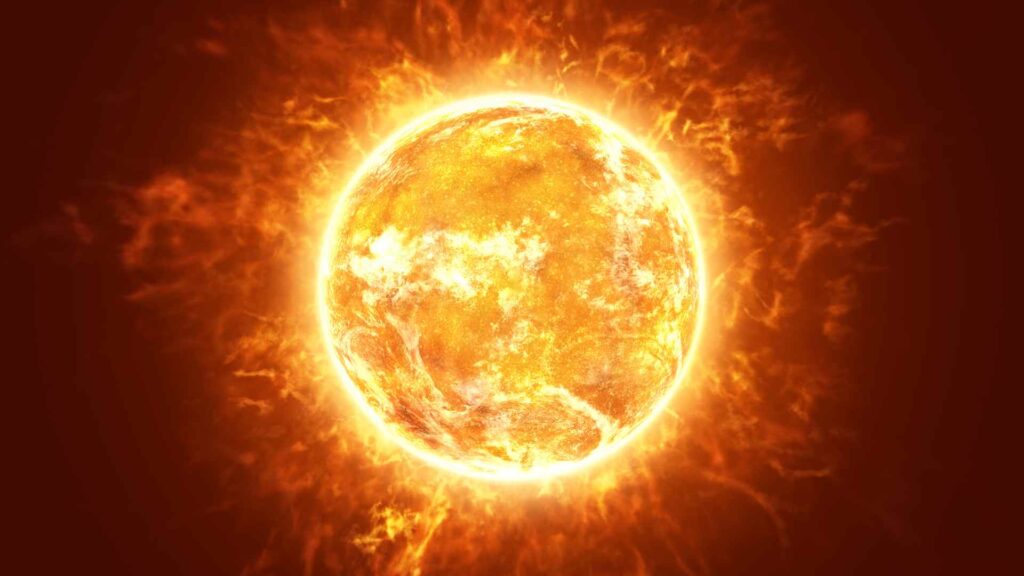The Sun is a mind-blowing star with mysteries and wonders that fuel life on Earth and shape the cosmos. Ready to dive into the awe-inspiring world of our nearest star?
Here’s a collection of fascinating facts about the Sun that will brighten your day, spark your curiosity, and maybe even surprise you!
The Formation and Structure of the Sun
- The Sun formed about 4.6 billion years ago from a collapsing cloud of gas and dust.
- It’s classified as a “G-type main-sequence star,” also known as a yellow dwarf.
- The Sun’s core reaches temperatures of around 27 million degrees Fahrenheit (15 million degrees Celsius).
- About 70% of the Sun’s mass is hydrogen, while 28% is helium.
- The Sun’s core is where nuclear fusion occurs, producing the energy that powers the solar system.
- Its structure includes the core, radiative zone, convective zone, photosphere, chromosphere, and corona.
- The Sun has an approximate diameter of 864,000 miles (1.39 million kilometers), over 100 times wider than Earth.
- If hollowed out, the Sun could contain over a million Earths inside it!
- Despite appearing yellow from Earth, the Sun is actually white in color.
- The Sun spins on its axis, but since it’s a giant ball of gas, its rotation varies by latitude.
- The solar core alone contains about 50% of the Sun’s entire mass.
- Every second, the Sun converts around 600 million tons of hydrogen into helium.
- The energy produced by the Sun’s core takes thousands of years to reach the surface.
- Scientists believe the Sun is almost halfway through its 10-billion-year lifespan.
- The Sun will eventually become a red giant and later transform into a white dwarf.

Solar Flares and Sunspots
- Solar flares are sudden bursts of radiation from the Sun’s surface.
- These flares are classified by intensity into classes: A, B, C, M, and X, with X being the most powerful.
- Sunspots are darker, cooler regions on the Sun caused by magnetic field disturbances.
- The number of sunspots fluctuates in an 11-year cycle, known as the solar cycle.
- Some solar flares are powerful enough to disrupt satellite communications and power grids on Earth.
- The largest solar flare recorded was in 1859, known as the Carrington Event.
- During the peak of the solar cycle, the Sun displays more solar activity, including flares and sunspots.
- Sunspots were first documented by ancient Chinese astronomers in the 4th century BC.
- The size of a sunspot can range from a small region to an area larger than Earth.
- In 1989, a massive solar storm knocked out power across Quebec, Canada.
- Solar flares release energy equivalent to millions of 100-megaton hydrogen bombs exploding simultaneously.
- Ultraviolet radiation from solar flares can reach Earth in about 8 minutes.
- During solar maximum, the Sun’s magnetic field reverses.
- Sunspots can last from a few days to a few months.
- The absence of sunspots for long periods can lead to cooling on Earth, such as the “Little Ice Age” from 1645 to 1715.
Solar Wind and Space Weather
- Solar wind is a stream of charged particles emitted from the Sun’s outer layer, or corona.
- This wind travels at speeds of about 1 million miles per hour.
- Earth’s magnetic field shields us from most of the solar wind.
- Auroras, such as the Northern Lights, are caused by the interaction between solar wind and Earth’s atmosphere.
- Intense solar wind events can generate geomagnetic storms.
- These storms have the potential to affect satellite operations, power grids, and GPS systems.
- The boundary where the Sun’s influence ends and interstellar space begins is called the heliopause.
- Solar wind extends past the orbits of the planets, influencing space weather.
- NASA’s Voyager 1 and Voyager 2 spacecraft have crossed the heliopause.
- The speed and density of the solar wind fluctuate depending on the Sun’s activity cycle.
- Coronal holes are regions on the Sun where solar wind is emitted at a higher speed.
- During solar minimum, the Sun emits less intense solar wind.
- Spacecraft, like the Parker Solar Probe, are studying solar wind and the Sun’s outer corona.
- The solar wind has a direct impact on the radiation environment in space, influencing astronaut safety.
- The Sun’s magnetic field is carried throughout the solar system by the solar wind.

The Sun’s Effect on Earth’s Climate and Seasons
- The Sun is the primary driver of Earth’s climate, providing energy for weather patterns and life.
- Solar radiation varies slightly, affecting Earth’s climate in subtle ways over long periods.
- The Earth’s tilt, not the Sun, causes the seasons by changing the angle of sunlight.
- During summer, Earth is actually farther from the Sun, but the tilt makes sunlight more direct.
- Solar energy is absorbed and re-emitted by Earth’s atmosphere, land, and oceans.
- Climate scientists study solar irradiance to understand long-term climate change patterns.
- Earth receives only one billionth of the Sun’s total energy output.
- A phenomenon called “insolation” measures the solar radiation Earth receives.
- Changes in solar activity have been linked to historical climate events.
- Solar cycles can contribute to subtle changes in global temperatures.
- The “Little Ice Age” in Europe coincided with a prolonged period of low solar activity.
- Solar power is a renewable energy source that harnesses the Sun’s radiation for electricity.
- Without the Sun, Earth would be too cold to sustain life.
- The Earth’s atmosphere scatters sunlight, creating blue skies and red sunsets.
- Solar energy is critical to the water cycle, causing evaporation and precipitation.
The Sun’s Role in the Solar System
- The Sun’s gravitational pull holds all planets, comets, and asteroids in the solar system.
- About 99.86% of the solar system’s total mass is contained in the Sun.
- The planets orbit the Sun in slightly elliptical paths due to gravitational forces.
- The Sun’s gravity controls the orbits of objects as far out as the Kuiper Belt.
- Comets are pushed by the solar wind, forming tails that point away from the Sun.
- The outer planets take much longer to orbit the Sun due to their distance.
- Mercury, the closest planet to the Sun, completes an orbit in just 88 days.
- Pluto’s orbit takes 248 Earth years to complete.
- The Sun’s gravitational influence is why planets remain in stable orbits.
- Tidal forces from the Sun and Moon affect Earth’s ocean tides.
- The Sun influences the orbits of asteroids and comets, sometimes pulling them into the inner solar system.
- The Oort Cloud, far beyond Pluto, marks the outermost boundary of the Sun’s gravitational reach.
- The Sun’s location in the Milky Way galaxy affects its orbit and movement.
- The Sun and the solar system orbit the center of the Milky Way once every 230 million years.
- Our Sun is just one of billions of stars orbiting in the galaxy.

Solar Eclipses and Phenomena
- A solar eclipse occurs when the Moon passes between Earth and the Sun.
- Total solar eclipses are visible only from a narrow path on Earth.
- During a total eclipse, the Sun’s corona becomes visible as a glowing halo.
- Solar eclipses are divided into total, partial, and annular types.
- The longest recorded total solar eclipse lasted around 7 minutes.
- Solar eclipses occur only during the new moon phase.
- Ancient cultures revered solar eclipses, often associating them with omens.
- Scientists use solar eclipses to study the Sun’s corona.
- The next total solar eclipse will occur in 2024.
- During an annular eclipse, the Moon appears smaller, creating a “ring of fire.”
- Solar eclipses are rare at any given location, occurring roughly every 375 years.
- The shadow cast by the Moon during an eclipse moves across Earth at over 1,000 mph.
- Solar eclipses have been documented by humans for thousands of years.
- The study of solar eclipses helped confirm Einstein’s theory of general relativity.
- Some animals react to solar eclipses by behaving as if it’s nighttime.
Myths and Cultural Significance of the Sun
- Ancient Egyptians worshiped Ra, the Sun god, as a creator and ruler.
- The Aztecs believed their Sun god needed human sacrifices for survival.
- Many Native American tribes have Sun dances as part of their traditions.
- In Hindu mythology, Surya is the god of the Sun and considered the soul of the universe.
- Ancient Greeks personified the Sun as Helios, who rode a golden chariot across the sky.
- The Incas viewed the Sun as a vital life force and built temples to honor it.
- The Sun features in countless myths, symbolizing life, power, and strength.
- Some cultures believed that solar eclipses were battles between good and evil.
- Japanese mythology speaks of Amaterasu, the Sun goddess, who hid in a cave and caused darkness.
- The ancient Chinese thought solar eclipses were dragons eating the Sun.
- In Norse mythology, a wolf named Skoll chases the Sun, causing eclipses when he catches it.
- Many cultures have sun-worship festivals timed with solstices.
- The Sun symbol has been a powerful icon in art, religion, and symbolism.
- The “sun cross” is an ancient symbol found in many cultures worldwide.
- Sun worship was often linked with kingship, as rulers were thought to embody solar power.
Bonus Facts About the Sun
- The Sun travels at around 514,000 miles per hour through the Milky Way.
- The Sun’s atmosphere has three layers: the photosphere, chromosphere, and corona.
- A particle of light (photon) can take millions of years to escape the Sun’s core.
- The Sun’s mass decreases slightly every second due to the energy it emits.
- Solar energy takes about 8 minutes and 20 seconds to reach Earth.
- Our Sun is brighter than 85% of the stars in the Milky Way.
- The Sun has a magnetic field that changes polarity roughly every 11 years.
- The hottest part of the Sun’s atmosphere is the corona.
- The Sun does not burn—it glows because of nuclear fusion.
- Solar prominences are loops of gas extending from the Sun’s surface.
- The Sun is currently in the stable “main-sequence” phase.
- Without the Sun’s gravity, planets would drift off into space.
- The Sun’s future red giant phase will likely engulf Mercury and Venus.
- The Sun’s light powers photosynthesis, the basis of life on Earth.
- Solar flares emit X-rays and ultraviolet radiation.
- The Sun has been emitting light for billions of years.
- The Sun influences Earth’s magnetic poles.
- Our Sun will one day become a planetary nebula.
- The Sun’s corona is hotter than its surface, an unsolved scientific mystery.
- Sunlight is a mixture of all colors, visible as white light.
- The Sun completes a rotation in about 25 days at the equator.
- Our Sun is part of a single-star system, unlike binary systems.
- Some spacecraft can operate on solar power.
- The Sun may trigger volcanic activity on Earth.
- The Sun and Earth share the same chemical elements.
- If you could hear it, the Sun would roar louder than 100,000 jet engines.
- The Sun doesn’t have a solid surface.
- Solar weather can affect whale migrations.
- Some astrobiologists believe life could exist in the Sun’s cooler spots.
- The Sun’s gravitational energy is stronger than any other object in the solar system.
- Ultraviolet light from the Sun causes sunburn.
- The Sun will spend billions of years as a white dwarf.
- Light from the Sun reflects off the Moon and back to Earth.
- The solar corona is a source of X-rays.
- The Sun is about halfway through its lifecycle.
- The Earth’s distance from the Sun varies throughout the year.
- The Sun’s rays are most intense at solar noon.
- Sunspot patterns are used to track solar activity.
- The Sun is a second-generation star, formed from previous star material.
- Space probes use solar power to gather energy.
- The Sun will eventually lose its outer layers.
- The Sun emits a “solar wind” that fills the solar system.
- Space weather forecasting is an emerging science.
- Cosmic rays from the Sun can reach the Earth’s surface.
- Solar science can help us understand other stars.
- The Parker Solar Probe is the closest spacecraft to the Sun.
- Solar cycles influence space travel planning.
- Solar eclipses are celebrated in festivals worldwide.
- The Sun’s heat can be stored in rocks on Earth.
- Scientists believe solar storms may become more intense in the future.
